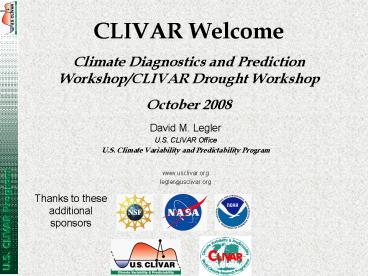David M. Legler PowerPoint PPT Presentation
Title: David M. Legler
1
CLIVAR Welcome Climate Diagnostics and Prediction
Workshop/CLIVAR Drought Workshop October 2008
- David M. Legler
- U.S. CLIVAR Office
- U.S. Climate Variability and Predictability
Program - www.usclivar.org
- legler_at_usclivar.org
Thanks to these additional sponsors
2
CLIVAR (Climate Variability and Predictability)
CLIVAR is an multidisciplinary research effort
within the World Climate Research Programme
(WCRP) focusing on the variability and
predictability of the slowly varying components
of the climate system. CLIVAR coordinates
activities in support of its mission to observe,
simulate and predict Earths climate system, with
focus on ocean-atmosphere interactions, enabling
better understanding of climate variability,
predictability and change, to the benefit of
society and the environment in which we live.
http//www.clivar.org
3
CLIVAR - Principal Research Areas
weeks - seasons - interannual seasons -
interannual - decadal decadal -
centennial
4
CLIVAR Drought Workshop, Wed-Fri
- Observing and monitoring drought
- Drought impacts, products, and addressing user
needs - Simulating drought
- Mechanisms that contribute to drought
- Predictability of drought/prediction capabilities
- Understanding and attribution of drought and its
impacts - incorporating climate predictions /projections in
the development and delivery of drought products
to meet societal needs
5
- DRICOMP (DRought In COupled Models) Project
- Follow-on to CMEP (Coupled Model Evaluation
Project) which was the kernel that lead to a
large international workshop (Hawaii) and many
papers that contributed to the IPCC FAR. - DRICOMP Evaluation of existing relevant model
simulations - CMIP3, Paleo Models, NARCCAP, SMIP, C20C
Aims Identify and characterize physical and
dynamical mechanisms leading to drought and the
mechanisms through which drought may change as
climate changes. Diagnose simulation of drought
in current models.
17 projects - supported by NOAA, NASA, NSF, and
DOE
6
Drought Working Group (16 members CLIVAR,
GEWEX, Service Providers, International
Scientists)
- http//www.usclivar.org/Organization/drought-wg.ht
ml
- Defining drought (observations and related model
predictands) - Coordinating key aspects of the (US) long-term
drought research agenda outlined in the 2005
drought workshop recommendations
- Coordinated Global Model Experiments Addressing
the Role of SSTs and Soil Moisture in Regional
Drought - Multiple modelling groups performed identical
idealized experiments to address issues of model
dependence on the response to SSTs (and the role
of soil moisture), and to look in more detail at
the physical mechanisms linking the SST changes
to drought - All runs 50 years, fixed SST patterns added to
seasonally varying SST climatology - Participating groups/models NASA (NSIPP1),
Lamont(CCM3), NCEP(GFS), GFDL (AM2.1), NCAR
(CAM3.5), and COLA/Univ. of Miami/ (CCM3.0)
7
WCRP Extremes
GEWEX and CLIVAR have agreed to catalyze
coordinate an international focus on drought
- Goals
- To summarize, compare and assess definition(s) of
climate extremes and develop a common language
amongst researchers and end users. - To design an intercomparison framework through
which both observations, model representations of
extremes projections of climate can be assessed
by which changes in climate extremes can be
better evaluated. - To accelerate progress on the prediction of
climate extremes with a focus on developing
capabilities and products which facilitate
practical applications for stakeholders (end
users/constituents) regions around the world. - To assess and improve the observational and
dataset framework for study of global extremes - To determine how extremes are changing and
varying and why (including their relationship to
mean variables, physical factors, shape of pdf
etc).
8
Have a great workshop!
9
(No Transcript)
10
U.S. CLIVAR Outlook
Two Major Opportunities Identified I
Drought II Decadal Variability Prediction
- US CLIVAR will continue to focus special effort
in the interagency and intra-agency context on
these topics - US CLIVAR panels will continue their
coordination, and other activities addressing
major research needs, including many that
intersect CPPA - US CLIVAR welcomes ideas for new Working Groups
(contact Panel co-chairs) - CPPA community should continue working with US
and Intl CLIVAR
11
U.S. CLIVAR Organization
US CLIVAR Scientific Steering Committee
Inter-Agency Group (IAG) Federal Program Managers
Committee
U.S. CLIVAR Office
Best Practices Research Priorities Coordination
Predictability, Predictions Applications
Interface (PPAI)
Panels
Phenomenology, Observations, Synthesis (POS)
Process Studies Model improvement (PSMI)
- As of September 2008
- Ocean Salinity (completed)
- MJO (completedIntl development)
- Drought
- Western Boundary Current
- High-latitude fluxes
- Decadal Prediction (to be considered)
- IESA (to be considered)
International CLIVAR
Working Groups (short-term)
Working Groups

